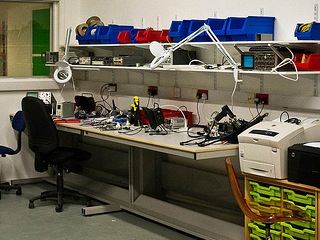Equipment/Electronics Workbenches
From Makespace
Equipment / Electronics Workbenches
Workbenches for electronics and precision work.
Contents
Enthusiast Bench
A 1800mm x 900mm ESD cantilever bench from here
Equipment
- Hameg HM-203s 20MHz analogue oscilloscope
- Black*Star Jupiter 500 0.1Hz-500kHz function generator (sine, square, sawtooth)
- Philips PM6622 80MHz counter
Expert Bench
A 1800mm x 900mm ESD cantilever bench from here
Equipment
- BlackJack BK6000 Rework station
- Philips PM 3217 50MHz analogue Oscilloscope
- Thurlby Thandar TG212 0.1Hz-2MHz function generator (sine, square, sawtooth)
- Thurlby Thandar TF830 1.3GHz high resolution reciprocal measurement
- Soldering irons:
- 2x Tenma AT60D soldering stations (up to 400C)
- Bench power supplies (e.g. a mix of 5V, 12V, variable, and multi-rail PSUs)
- Farnell AP20-80: up to 20V at up to 80A
- Hameg HM7042-3 dual: each channel up to 32V at up to 2A
- Tenma 72-8695 two channels each up to 32V at up to 3A, plus a single fixed 5V/2A channel
- Logic analyser:
- HP 16500A (status unknown: may not be operational but has probes pack)
- Currently assumed dead.
Components and small tools
- PCB holders or "helping hands"
- Magnifying lamps
- Side cutters
- Multimeters
- Wire
- Selection of basic components (res, caps, v-reg, basic digital logic, basic IC's - 555,358, connectors, cable)
Notes
It would be nice if someone could dig out URLs for manuals for the above, if available, and link to them from their listing lines.
Wishlist
Need
- Abrasive pen
- Heatsink tweezers
- Tweezers
- ESD handling equipment, eg. anti-static mats, wrist-strap, earth points, tester
Want
- Logic Analyser
- 100MHZ Digital Oscilloscope
Would Be Nice
- USB microscope with monitor
- Spectrum Analyser
Archive
Bench Requirements (based on conversations with lots of people!)
- Height: Standard workstation/stool height (~840mm) rather than desk/chair height - allows working standing or sitting on stools
- Depth: Standard electronics workstation depth of ~900mm to allow for equipment at the back whilst still giving decent workspace
- ESD - whilst some people don't care, other seem to care a lot, so assume antistatic worksurface
- Structure - A long workbench surface along the wall of the main workshop, approximately 4m; Options:
- Standard electronics workbenches (metal structure bench with drawers below left/right, back power strip at back, raised shelf)
- Basic electronics workbences without storage below, cantilever or 4-post design
- Worksurface (e.g. kitchen) fixed to wall with some drawer units as stands (e.g. ikea)
- Other considerations:
- Allow for a variable number of people to sit at it (i.e. bunch up, couple of people around same project)
- Decent storage for all the basic tools, components
- Some form of raised area for scopes/test equipment
- Very sturdy - i.e. wont move if lent on, pushed against etc

